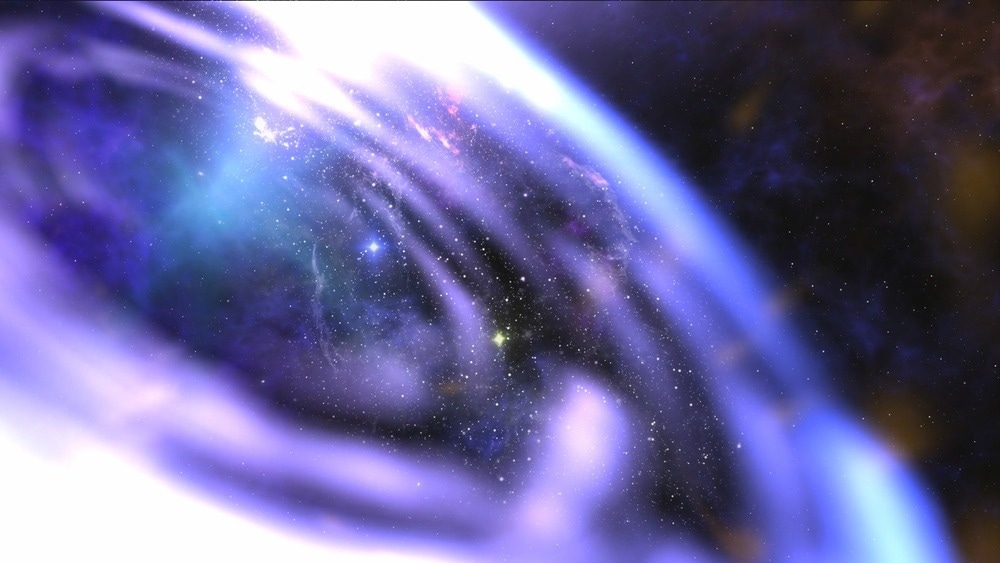An estimated 85% of the universe's constituents are assumed to be made up of dark matter, a hypothetical type of matter. Dark matter is entirely invisible. Since it doesn't emit any light or energy, ordinary sensors and detectors are unable to pick it up. Scientists believe that its composition must hold the key to understanding the beginnings of the cosmos and the physics of the universe.

Image Credit: Antrakt2/Shutterstock.com
Baryons, a general term for subatomic particles including protons, neutrons, and electrons, make up visible matter, also known as baryonic matter. What dark matter is constituted of is a topic of conjecture among scientists. It might be made of baryons, but it might also be non-baryonic and made of many kinds of particles.
Detecting Dark Matter
Cosmic microwave background (CMB), a type of radiation that was generated at the Big Bang and is dispersed over the whole cosmos, is the key to mapping dark matter in the very early universe.
The most distant galaxies are billions of years old as the farther away a galaxy is, the longer its light has been traveling to reach an observer on Earth. Astronomers can observe galaxies in their state at which the light left them, as the light takes a particular amount of time to reach Earth from distant objects.
Although around 85% of the universe's entire mass is made up of dark matter, an unknown element, it is considerably more difficult to observe as it does not interact with light or other matter.
Astronomers rely on dark matter's interaction with gravity in order to "see" its effects. The curvature of space-time is caused by massive objects, according to Einstein's theory of relativity. A flexible plastic sheet, like a plastic shopping bag from the local grocery store, containing balls of increasing bulk is a typical example. The size of the sheet's "dent" is directly proportional to the mass of the object. Likewise, the more severely space-time is bent by a cosmic object, the greater it is.
Space-time is significantly bent by massive objects like galaxies to the point where light generated from behind a galaxy is also bent. This gravitational lensing effect causes the light source's location in the sky to change.
Astronomers can analyze how light from a source behind a galaxy is altered as it passes the "lens galaxy" in order to study the distribution of dark matter in that galaxy. The distortion of light flowing through a lens galaxy increases with the amount of dark matter it contains.
But there are drawbacks to this method. As astronomers gaze deeper into the cosmos and farther back in time, the signals become harder to observe. This is because the earliest and most distant galaxies are very faint. Due to this issue, the mapping of the distribution of dark matter has been restricted to galaxies that are 8–10 billion years old.
Compared to galaxies, the CMB offers an even older light source. When the cosmos cooled down sufficiently for atoms to form, fewer free electrons were available to scatter photons, leading to the creation of the CMB, which cosmologists refer to as "the last scattering."
The universe abruptly ceased being opaque to light and started to become transparent to light because of the decrease in free electrons, which allowed photons to flow freely.
The CMB can also be interfered with by galaxies with dark matter owing to gravitational lensing, just like light from other far-off sources.
In recent studies, scientists have found dark matter as early as 1.7 billion years ago by combining lensing distortions from many early galaxies with those of the CMB. And this old dark matter depicts a completely different view of the cosmos. More young galaxies and first galaxy clusters are visible now than previously observed. Between 100 and 1,000 galaxies may make up these clusters, which are gravitationally connected to substantial volumes of dark matter.
New Look At the Early Universe
Some early analyses of emerging data imply that dark matter in the early cosmos is less "clumpy" than many current cosmological models describe. The prospect that dark matter could be less spatially dense in the early cosmos could be transformational within the theory of cosmology.
For instance, according to the generally accepted Lambda-CDM model, the CMB's minute variations should have caused gravity to form densely packed pockets of matter. These fluctuations should produce pockets of dense dark matter in addition to the final collapse of other matter into galaxies, stars, and planets.
Future Outlook
This intriguing observation could point to further theoretical developments that could shed light on the characteristics of dark matter. Further information gathered is expected to determine if the Lambda-CDM model agrees with observations of dark matter in the early cosmos or whether the model's underlying presumptions need to be changed. Data from the Legacy Survey of Space and Time (LSST) of the Vera C. Rubin Observatory is expected to enable the examination of dark matter much further in the past.
More from AZoQuantum: The History of Cosmic Ray Research
References and Further Reading
Lea, R. (04 May 2023) If dark matter is 'invisible,' how do we know it exists? [Online] Space.com. Available at: https://www.space.com/if-dark-matter-invisible-how-do-we-know-it-exists
Lea, R. (02 August 2022) Dark matter from 12 billion years ago detected for the 1st time. [Online] Space.com. Available at: https://www.space.com/dark-matter-ancient-galaxy-detection
Griffin, A. (01 August 2022) Dark matter from billions of years ago finally detected by scientists. [Online] Independent.co.uk. Available at: https://www.independent.co.uk/space/dark-matter-universe-cosmos-years-b2135688.html
Disclaimer: The views expressed here are those of the author expressed in their private capacity and do not necessarily represent the views of AZoM.com Limited T/A AZoNetwork the owner and operator of this website. This disclaimer forms part of the Terms and conditions of use of this website.